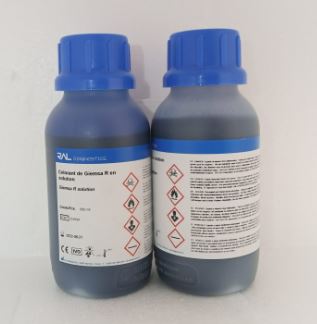GIEMSA, stain, solution, 500 ml, bot.
Valid Article
GIEMSA, stain, solution (Merck)
Definition
Ready to use solution intended for staining blood smears and blood samples.
Synonym
Methylene blue azure eosine dye, Giemsa's azur eosin methylene blue solution
Specifications
Technical specifications
- Solution
- Composition: giemsa, glycerol, methanol
Packaging & Labelling
Botlle of 500 ml or 1 l
Transport Dangerous Goods
- UN1230
- Class: 3 (6.1)
- Packing group: II
- Proper shipping name: Methanol solution
Instructions for use
For acting, the Giemsa should always be used diluted. Depending on the dilution, the staining will be rapid or slow.
FOR INFORMATION:
- Rapid staining: 10% dilution with staining time of 8-10 minutes
- Slow staining : 3% dilution with staining time of 45-60 minutes
These times vary according to the quality of the Giemsa and you need to make some tests to find out the best protocol.
To guarantee the staining quality, the dilution should be performed extemporaneously with buffered water at pH 7.2.
Please consult the “Updated laboratory procedures, 2022” available online via the Laboratory working Group sharepoint page: Laboratory Procedures and Resources.
https://msfintl.sharepoint.com/sites/msfintlcommunities/LabWG/SitePages/Laboratory-Manual-page.aspx
For offline access, contact your laboratory advisor.
Storage
- Protected from light and humidity
- Expiry date indicated on the bottle
- Store between 15 and 25°C
CAUTION
Parcels with IATA packaging are marked "METHANOL", which can result in errors when storing the goods.
Waste management
Substance with hazardous characteristics. Please contact your watsan referent for advice on proper disposal.
Detailed hazard and precautionary information can be found in the safety data sheet (SDS).
Classification EC Regulation N° 1272/2008
- Flammable liquids: Category 2, H225
- Acute toxicity, Oral: Category 3, H301
- Acute toxicity, Inhalation: Category 3, H331
- Acute toxicity, Dermal: Category 3, H311
- Cutaneous sensitization: Category 1, H317
- Specific target organ toxicity - single exposure: Category1, H370
Signal Word
Danger
| H225 | Highly flammable liquid and vapour |
| H317 | May cause an allergic skin reaction |
| H370 | Causes damage to organs (or state all organs affected, if known) (state route of exposure if it is conclusively proven that no other routes of exposure cause the hazard). |
| H301 + H311 + H331 | Toxic if swallowed, in contact with skin or if inhaled |
| P210 | Keep away from heat/sparks/open flames/hot surfaces. – No smoking. |
| P233 | Keep container tightly closed. |
| P280 | Wear protective gloves/protective clothing/eye protection/face protection |
| P301 + P310 | IF SWALLOWED: Immediately call a POISON CENTER or doctor/physician. |
| P303 + P361 + P353 | IF ON SKIN (or hair): Remove/Take off immediately all contaminated clothing. |
| P304 + P340 + P311 | N CASE OF INHALATION: take the person outside and hold them in a position position where they can breathe comfortably. breathe. Call a POISON CENTER / doctor. |
MSF requirements
The Giemsa is the stain of reference for malaria: with a pH 7.2 buffer solution, it clearly shows the contrast between the parasites and the blood elements.
If you want to use FIELD stain A and B, contact your laboratory advisor.


![[KMEDMHLA14D] (mod hospital lab) REAGENTS regulated transport](/web/image/product.template/572571/image_256/%5BKMEDMHLA14D%5D%20%28mod%20hospital%20lab%29%20REAGENTS%20regulated%20transport?unique=db7133d)
![[KMEDMLAB04D] (laboratory module) MALARIA REAGENTS, 1000 tests, RTR](/web/image/product.template/573208/image_256/%5BKMEDMLAB04D%5D%20%28laboratory%20module%29%20MALARIA%20REAGENTS%2C%201000%20tests%2C%20RTR?unique=c558e3e)
![[SLASBUFF7P2] BUFFER, pH 7.2 (Merck), tab. for 1 l](/web/image/product.template/570530/image_256/%5BSLASBUFF7P2%5D%20BUFFER%2C%20pH%207.2%20%28Merck%29%2C%20tab.%20for%201%20l?unique=0ea9c84)